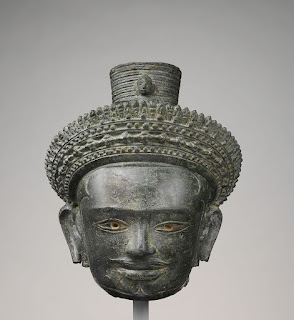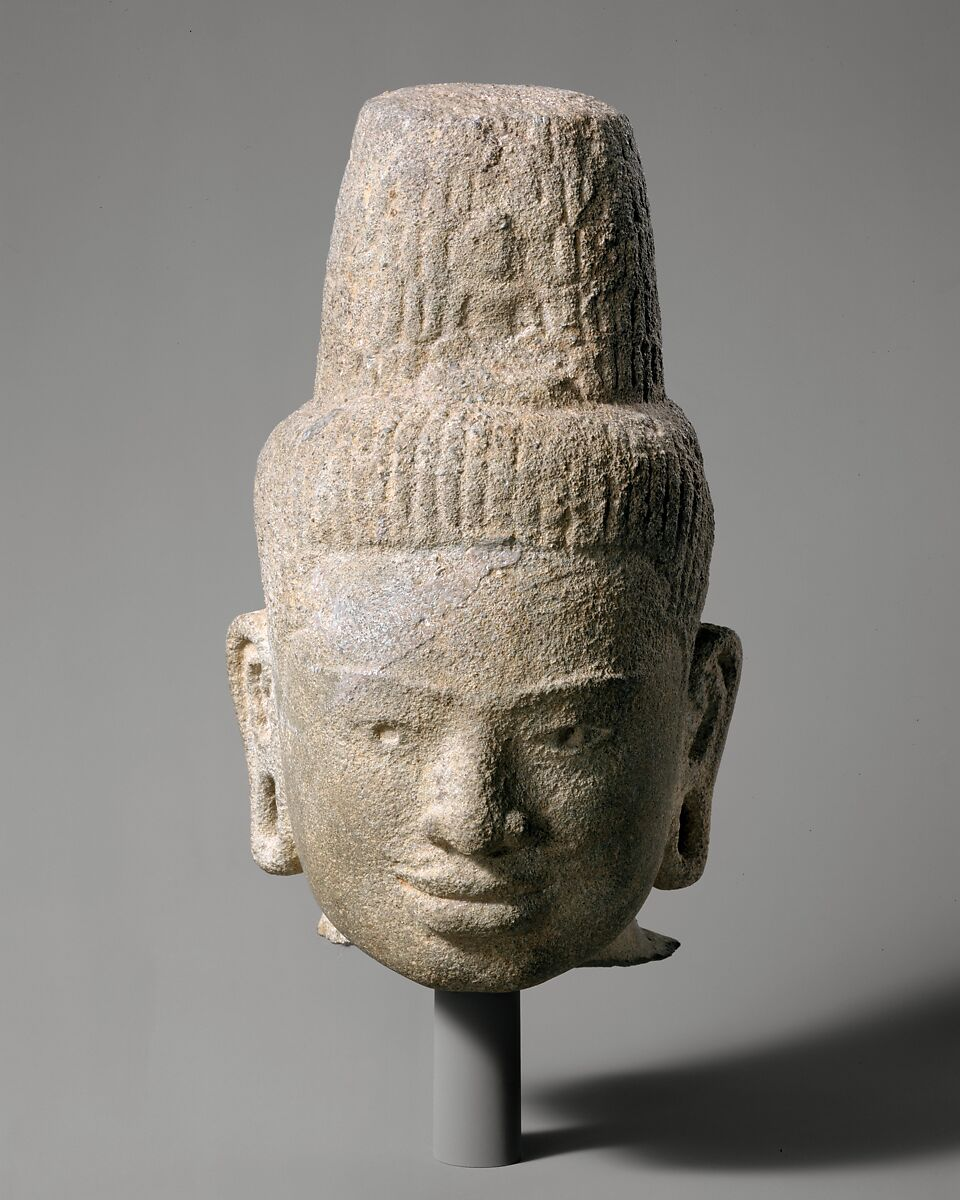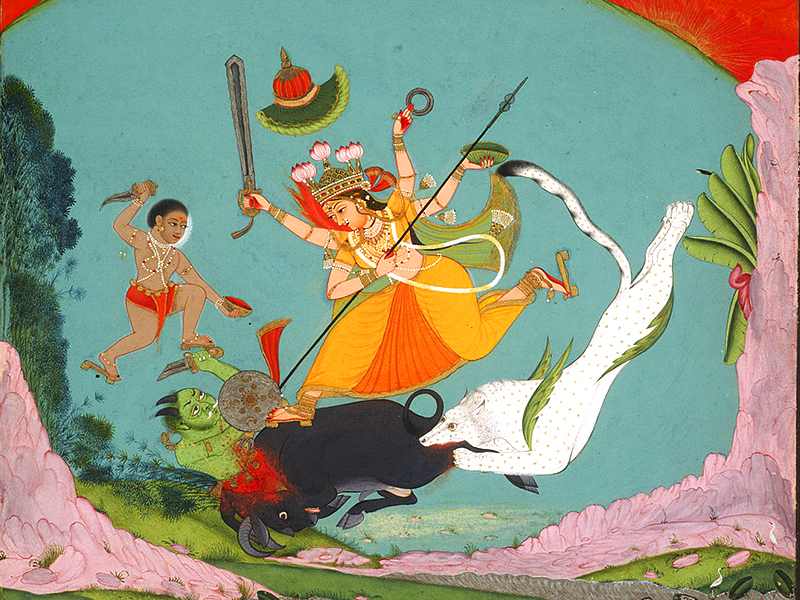 |
Looted Cambodian art for sale by Douglas Latchford
Image Credit: US DOJ |
In a case being prosecuted by Assistant U.S. Attorney Jessica Feinstein, in the Office’s Money Laundering and Transnational Criminal Enterprises Unit, prominent 88-year-old British art collector and dealer Douglas A.J. Latchford has been indicted in the US Federal Court of the Southern District of New York. The charges against the Bangkok-based dealer include
"wire fraud, smuggling, conspiracy and related charges pertaining to his trafficking in stolen and looted Cambodian antiquities."
 |
Latchford in his home standing next to
a Chola period (880 - 1279) Somaskanda from Tamil Nadu |
For 50 years Latchford has been considered one of the world’s leading authorities on Asian Art, and at one point was believed to be the biggest single contributor to the National Museum of Cambodia, one of the very countries outlined in the indictment unsealed today at the US Federal Courthouse in Manhattan. According to the prosecution, Latchford is believed to have been a major stakeholder, acting as a cross-border conduit in an multi-billion dollar cultural property network which trafficked in plundered artifacts from Southeast Asia to some of the most important galleries, auction houses, and museums in the western world charging him with conspiracy to smuggle, false import statements, wire fraud, and the illicit transport and sale of stolen cultural property.
According to the US indictment it is alleged that
"from at least in or about 2000, up to and including at least in or about 2012, Latchford engaged in a fraudulent scheme to sell looted Cambodian antiquities on the international art market, including to dealers and buyers in the United States."
 |
| The statue of warrior Duryodhana, which once graced the cover of Sotheby’s Asia Week catalog was returned to Cambodia. In situ, this warrior was one of two matching statues facing each other in a rendition of the great Hindu epic the Mahabharata. |
Included in that list of fraudulent activity is involvement in the illicit removal and sale of the Angkorian sandstone statues stolen from Prasat Chen, the most northern sanctuary in the remote Koh Ker temple complex in Northern Cambodia. Koh Ker (Khmer: ប្រាសាទកោះកេរ្ដិ៍) sits 120 kilometres northeast of Siem Reap and was briefly the capital of the Khmer kingdom from 928 to 944 CE.
In 2012, Latchford was
already identified in a civil lawsuit, as a middleman in the trafficking of looted Khmer sculptures from “an organized looting network” and said to have conspired with the London auction house Spink & Son Ltd., to obtain false export permits for the sandstone temple antiquities.
Some of the incriminating evidence against the dealer related to charges against him include a brazenly written email sent on/about April 23, 2007, which leaves little to no doubt about the dealer's level of direct involvement and knowledge in transnational criminal activity against cultural artifacts. Attached to this email was a photograph of a freshly (and clandestinely) excavated standing Buddha statue, still covered in dirt. In that email, Latchford is reported as having written
"Hold on to your hat, just been offered this 56 cm Angkor Borei Buddha, just excavated, which looks fantastic. It’s still across the border, but WOW.”
It should be noted that by 1996, Cambodia had already enacted its overarching Law on the Protection of Cultural Heritage, which criminalizes both the unauthorized excavation, looting, and unauthorized export of antiquities, defining "movable cultural property found by chance" to be public property. This law, known colloquially as "the 1996 Law" remains in effect and is the relevant governing law, supported by a number of decrees, sub-decrees, and regulations. Cambodia further demonstrates its determination to protect its cultural heritage by being a signatory to the Convention for the Protection of Cultural Property in the Event of Armed Conflict (joined 1962); the 1970 UNESCO Convention on the Means of Prohibiting and Preventing the Illicit Import (joined 1972); the World Heritage Convention (joined 1991); the Convention on Stolen or Illegally Exported Cultural Objects (joined 2002), and the Convention on the Protection of the Underwater Cultural Heritage (joined 2007).
As part of the present indictment Latchford is also alleged to have created
"false letters of provenance and false invoices" misrepresenting the nature, age, country of origin, and/or the value of an antiquity in order to conceal the illicit nature of the objects he brokered. It should also be mentioned that he is also mentioned obliquely,
though not directly named, as Co-Conspirator #1, in the criminal complaint filed by the Manhattan district attorney against Nancy Wiener, and several co-conspirators in December 2016.
 |
| Douglas Latchford at his home in Bangkok, Thailand |
In that New York criminal complaint co-conspirator #1 (Latchford)
- allegedly is an antiquities dealer based in London and Bangkok
- allegedly entered into an agreement with Nancy Wiener to purchase and sell a looted Baphuon Shiva from Cambodia, dated to the 11th Century C.E
- allegedly shipped the Baphuon Shiva to London to be “cleaned, put together, and mounted.”
- allegedly sold Nancy Wiener a bronze Buddha sitting on a throne of Naga stolen from Thailand or Cambodia, dated to the 10th Century C.E.
- allegedly falsified provenance along with Nancy Wiener and Co-conspirator 2 for the bronze Buddha sitting on a throne of Naga stolen from Thailand or Cambodia, dated to the 10th Century C.E.
- allegedly is a male
- allegedly admitted in email that he gave Co-Conspirator #2 bronze statues in exchange for false letters of provenance
- allegedly purchased the Krishna Dancing on Kaliya from Subhash Kapoor
- allegedly colluded with Nancy Wiener to create appraisal report for the Krishna Dancing on Kaliya
Evidence collected in both cases illustrate a textbook formula of how looted antiquities are laundered onto the licit art market through poor controls and a lack of ethics and transparency among the major dealers working at the highest levels of the ancient art market.
Note: the charges contained in the US indictment are merely accusations and the defendant should be presumed innocent unless and until proven guilty. For now Latchford, in purportedly poor health, remains at large in Bangkok, though it should be noted that the USA & Thailand signed an agreement on December 14, 1983 in which Article 2 permits extradition for any offense punishable under the laws of both States by imprisonment for more than one year. By unsealing this indictment, it seems that the US intends to bring Latchford to the US, despite his reported ill health, to stand trial.
In conclusion, ARCA has elected to transcribe the entire SD/NY statement below, to make it searchable by future scholars conducting open source research on known/suspected traffickers.
----------
Geoffrey S. Berman, the United States Attorney for the Southern District of New York, and Peter C. Fitzhugh, the Special Agent in Charge of the New York Field Office of the Homeland Security Investigations (“HSI”), announced today the unsealing of an indictment charging antiquities dealer DOUGLAS LATCHFORD, a/k/a “Pakpong Kriangsak”— with wire fraud, smuggling, conspiracy and related charges pertaining to his trafficking in stolen and looted Cambodian antiquities. LATCHFORD remains at large, residing in Thailand.
U.S. Attorney Geoffrey S. Berman said: “As alleged, LATCHFORD built a career out of the smuggling and illicit sale of priceless Cambodian antiquities, often straight from archeological sites, in the international art market. This prosecution sends a clear message to the art market and to those who profit from the illegal trafficking of cultural treasures: the United States and the Southern District of New York will use every legal tool to stop the plundering of cultural heritage.”
HSI Special Agent in Charge Peter C. Fitzhugh said: “The theft and trafficking of cultural property and priceless national treasures is a global concern. Historical artifacts are living sources of knowledge, objects of worships, and symbols of hope that must be safe guarded for future generations. Through the investigative efforts of HSI special agents, three stolen artifacts from Cambodia and another from India, valued at a total of $750,000, were successfully recovered and will be returned to their rightful homeland. In addition, an alleged major player in a multi-billion dollar cultural property transnational criminal network was identified and revealed. Working hand in hand with our partners at the United States Attorney’s Office, Southern District of New York, HSI will not waiver in its commitment to stopping the illicit distribution of cultural property, both domestically and abroad.”
According to the allegations in the Indictment unsealed today in Manhattan federal court:
Background on Looting of Cambodian Antiquities
From the mid-1960s until the early 1990s, Cambodia experienced continuous civil unrest and regular outbreaks of civil war. During these times of extreme unrest, Cambodian archeological sites from the ancient Khmer Empire, such as Angkor Wat and Koh Ker, suffered serious damage and widespread looting. This looting was widely publicized and well-known to participants in the international art market.
Looted artifacts usually entered the international art market through an organized looting network. Local looters, often working with local military personnel, would remove statues and architectural elements from their original locations, sometimes breaking and damaging the antiquities in the process of excavation and transportation. The antiquities would be transported to the Cambodia-Thailand border and transferred to Thai brokers, who would in turn transport them to dealers of Khmer artifacts located in Thailand, particularly Bangkok. These dealers would sell the artifacts to local or international customers, who would either retain the pieces or sell them on the international art market. Widespread looting of ancient Khmer and Cambodian antiquities continued into the 1990s.
The Scheme to Sell Looted Cambodian Antiquities
At all times relevant to this Indictment, DOUGLAS LATCHFORD, a/k/a “Pakpong Kriangsak,” the defendant, was a prominent collector and dealer in Southeast Asian art and antiquities, in particular, ancient Cambodian art. Starting in or about the early 1970s, LATCHFORD supplied major auction houses, art dealers, and museums around the world, including in the United States, with Cambodian antiquities from the ancient Khmer Empire. LATCHFORD, a dual citizen of Thailand and the United Kingdom, maintained residences in Bangkok and London.
From at least in or about 2000, up to and including at least in or about 2012, LATCHFORD engaged in a fraudulent scheme to sell looted Cambodian antiquities on the international art market, including to dealers and buyers in the United States. As part of that scheme, in order to conceal that LATCHFORD’s antiquities were the product of looting, unauthorized excavation, and illicit smuggling, and to encourage sales and increase the value of his merchandise, LATCHFORD created and caused the creation of false provenance for the antiquities he was selling. In the context of art and antiquities, provenance refers to records and other evidence documenting the origin and history of ownership of an object. In particular, LATCHFORD misrepresented the provenance of Cambodian antiquities in letters, emails, invoices, and other communications. As part of the scheme, LATCHFORD also falsified invoices and related shipping documents to facilitate the international shipment of the antiquities to dealers and buyers, and to avoid restrictions on the importation of Khmer antiquities into the United States.
Beginning in or about the early 1970s, LATCHFORD regularly supplied an auction house based in the United Kingdom (“Auction House-1”) with looted Khmer antiquities, including from the archeological site of Koh Ker in Cambodia. LATCHFORD conspired with representatives of Auction House-1 and others to conceal the real provenance of looted Khmer antiquities and to create false export licenses and documentation. Many of the antiquities that LATCHFORD consigned to Auction House-1 were eventually sold to museums and collectors in the United States. In or about 2011, an auction house in New York (“Auction House-2”) offered for sale one of the Koh Ker statutes that LATCHFORD had originally supplied to Auction House-1, a stone guardian figure called the “Duryodhana.” During the course of preparing to sell the Duryodhana in or about 2010, Auction House-2 asked LATCHFORD and a scholar closely associated with LATCHFORD (the “Scholar”) to help trace the provenance of the Duryodhana back to the early 1970s. LATCHFORD falsely stated to Auction House-2 that he had the Duryodhana in London in 1970, and that he had consigned it with Auction House-1 in 1975; whereas in truth and in fact LATCHFORD had exported the Duryodhana from Cambodia in or about 1972. About a month later, LATCHFORD changed his story, telling Auction House-2, in substance and in part, that he had never owned the Duryodhana. Around the same time that LATCHFORD falsely denied owning the Duryodhana, the Scholar warned LATCHFORD in an email, “I think maybe you shouldn’t be known to have been associated with the Koh Ker Guardian figures[.] . . . Let’s fudge a little, and just put the blame squarely on [Auction House-1] . . . .”
Over the course of his lengthy career, LATCHFORD continued to act as a conduit for recently looted Cambodian antiquities. LATCHFORD advertised purportedly newly discovered and excavated pieces for sale to trusted associates, including a Manhattan-based dealer in Southeast Asian art (the “Dealer”). For example, on or about August 12, 2005, LATCHFORD emailed the Dealer photographs of a bronze seated Buddha, visibly covered in earth. Latchford explained that the photographs showed the statute “before cleaning” by a restorer, and “[w]hen it was found they took off most of the mud, or as it was, a sandy soil, it was found near Sra Srang, the lake in front of Banteay Kedi, right in the Angkor [Wat] Complex.” Similarly, on or about March 13, 2006, LATCHFORD sent the Dealer an email labeled “PRIVATE AND CONFIDENTIAL -------- FOR YOUR EYES ONLY.” The email contained a photograph of a bronze head. LATCHFORD explained that the head “was recently found around the site of the Angkor Borei group in the N E of Cambodia, in the Preah Vihar area. They are looking for the body, no luck so far, all they have found last week were two land mines !! What price would you be interested in buying it at? let me know as I will have to bargain for it.” On or about April 23, 2007, LATCHFORD sent the Dealer another email, attaching a photograph of a standing Buddha statute that appears to be covered in dirt. LATCHFORD wrote, “Hold on to your hat, just been offered this 56 cm Angkor Borei Buddha, just excavated, which looks fantastic. It’s still across the border, but WOW.”
In order to facilitate the sale and international transportation of the antiquities to buyers and to conceal that the antiquities were looted, LATCHFORD, created false letters of provenance and false invoices, including letters of provenance purporting to have been drafted by a particular art collector (the “False Collector”). For example, in or about 2000, LATCHFORD sold a 12th Century stone Khmer sculpture to a museum in Colorado (the “Colorado Museum”). LATCHFORD informed the Colorado Museum that he had purchased the piece from the False Collector in June 1999, and provided the Colorado Museum with a letter of provenance purportedly from the False Collector as part of the sale. However, LATCHFORD also supplied the Colorado Museum with records indicating that the statute was transported from LATCHFORD’s residence in Bangkok to London in 1994, long before he claimed to have purchased it from the False Collector. The False Collector died in or about 2001. Thereafter, LATCHFORD continued to provide numerous provenance letters purportedly provided by the False Collector, while claiming, falsely, that the False Collector was still alive.
On other occasions, LATCHFORD directed third parties to create false provenance documents and false invoices for him. For example, in or about September 2005, LATCHFORD sold the Dealer a 12th Century Angkor Wat-style standing Buddha statue for $90,000. LATCHFORD told the Dealer that the Buddha “needs to be cleaned, as there is surface corrosion and earth still on it,” indicia of recent excavation. LATCHFORD arranged to ship the Buddha from Bangkok to an “antique consultant/collector” in Singapore (the “Singapore Collector”), and from Singapore to the Dealer’s gallery in Manhattan. LATCHFORD instructed the Singapore Collector to “re-invoice[]” the Buddha on the Collector’s letterhead, “mentioning it has been in your collection for the past 12 years.” The Singapore Collector followed LATCHFORD’s instructions, creating a new, false invoice and letter of provenance stating that the Buddha had been in the Singapore Collector’s private collection in Singapore for the last 12 years, omitting any mention of LATCHFORD, and falsely describing the statute as a “17th C. Bronze Standing Figure from Laos.” The Singapore Collector then shipped the Buddha with the false invoice and false provenance to the Dealer in Manhattan.
As part of the scheme to sell looted Cambodian antiquities in the United States, from at least in or about 2005 up to and including in or about 2011, LATCHFORD supplied false information to the United States Customs and Border Protection (“CBP”) regarding the antiquities he imported into the United States for resale. In particular, LATCHFORD’s false invoices misstated the nature, age, country of origin, and/or value of the Cambodian antiquities. LATCHFORD misrepresented the country of origin and the age of the goods in particular in order to conceal that they were looted antiquities, and to avoid an embargo on the importation into the United States of Khmer antiquities exported from Cambodia after 1999. Frequently, LATCHFORD listed the “country of origin” as “Great Britain” or “Laos,” rather than Cambodia, and often described the objects as “figures” from the 17th or 18th century.
* * *
 Cambodia,Douglas Latchford,Homeland Security Investigations,illicit antiquities,illicit trade in antiquities,Manhattan District Attorney,Nancy Wiener,New York,Thailand,The Metropolitan Museum of Art
Cambodia,Douglas Latchford,Homeland Security Investigations,illicit antiquities,illicit trade in antiquities,Manhattan District Attorney,Nancy Wiener,New York,Thailand,The Metropolitan Museum of Art
 No comments
No comments

.jpeg)
































